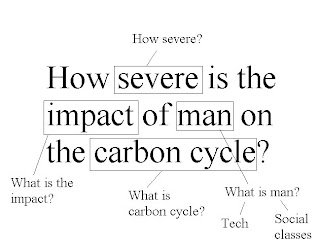|
|
♥ Monday, February 9, 2009 ♥
okay, today we watched a video, "The inconvenient truth" and the blog post will answer the question "To what extent should we be concerned about carbon dioxide emissions?" based on it. Basically, our Earth is livable due to the presence of the atmosphere. However, it is very thin, and vulnerable such that we can change its composition. Although one may arue that the atmosphere is really huge, it is actually only as thick as a coat of varnish on a ball, imagining that the ball is of the sanme size as the Earth, so ya, our atmosphere is really thin. Apparently, our atmosphere keeps our Earth warm by retaining some of the sun's radiation, however, it is thickening as increasing carbon dioxide is being emitted. This thickening of the atmosphere is resulting in more outgoing infrared radiation to get trapped and thus leading to global warming.
The concentration of carbon dioxide is also directly proportional to the temperature. In 650, 000 years in the past, the carbon dioxide level never exceeded 300 million parts per million, now however, it far exceeds 300 million parts and this level is predicted to go up for the next 50 years or more. More carbon dioxide in the air will also just mean a higher tenperature of the Earth as more heat is trapped from the Sun. Global warming thus occurs.
Global warming is having negative effects world widely. One example is the rise in temperature leading to the melting of glaciers world-wide and the Himalayas. However, the spring water from the Himalayas is providing 40% of the earth's population with water supply, and the melting of the whole Himalayas will just result in this 40% without water.
One of the effect of global warming that is often unnoticed is the increase in precipitation worldwide. When there are storm conditions, all these precipitate will just come down together. One example is the rain in India when there was 37 inches of rain within 24 hours, resulting in the biggest downpour ever in India. However, the precipitate is often relocated due to global warming, causing floods and droughts to occur simultaneously in neighbouring provinces. lakes are also dried up and water is evaporated from oceans and even soil. People then have to be relocated as where they live are often determined by climate patterns and global wamring is changing these patterns.
The Arctic is one of the places which is receiving the fastest impact of global wamring. Permafrost is thawing, resulting in the collapsing of buildings and trees not standing straight. Moreover, in 1970, there was a decrease in the amount, extent and thickness of th Arctic ice cap by about 40%. By an approximate 40 to 50 years time, it is guessed that the ice cap would have be completely gone.
With global warming, polar bears are also for the first times, reported to drown. This is due to the decrease in ice in the oceans. When the sun shnes, the ice reflects back the heat while the open ocean absorbs the sun energy. Withthe rising temperature, the water absorbs more heat energy and warms up, thus melting the ice into open waters. As a result, there is no more ice to reflect the sun's energy but all has melted to become water, absorbing the heat energy. This causes polar bears to swim for miles looking for ice, yet being unable to find one and drowning.
There are also planetary effects which will be affected. Heat is regulated by wind and ocean currents. These currents are formed when water sinks due to higher density from the salt content and becomes cold water. The cold water sinks at 5 billion gallons per second which results in the direction of the currents to go South resulting in the currents. With this, an ncrease of 5 degrees of the Earth, the equator increases by 1 degree while the poles increase by 12 degrees and the Earth's average temperature is 55.8 degree farenheight. However, these currents can be disrupted. For example, when the dam at the Great Lakes(melted water) broke, water gushed out and reduced the concentration of salt content in the water, causing the currents to jam.
Glabal warming can also result in a change in seasons, like for the hatching seasons of animals. In the past, the peak of hatching seasons for the birds and worms are the same, thus the birds will always have enough food to eat. However, recently, the peak of the hatching season for the worms are earlier and the hatching season for the birds is unable to catch up with it, thus leading to hunger of the birds.
Number of days with frost are also decreasing with the years. Pine beetles which are often killed by the frost can now survive more due to the days of frost decreasing. This will then lead to the destruction and devastation of the pine trees): Furthermore, due to higher temperatures, mosquitoes can climb to higher altitudes and new diseases such as SARS are emerging. Diseases such as Avian flu and West Nile, which were under control for a very long time, have also re emerged. Coral reefs have been bleached and organisms dependent on it are also affected.
Someone also mentioned that ice shelves in Antartica breaking is a great alarm bell for glabal warming. That is exaclty what is happening, one example is Larsen B. With this breaking ice shelves(floating ice), pools of water used to find the problem are increasing. Land based ce supported by the floating ice also falls into the ocean, increasing the sea level. One analogy provided was the one of ice cubes in a cup. When the ice cube is already in the liquid, melting of it will not raise the water level. However, when the ice cube is resting on the top of other ice cubes, melting of the paricular ice cube which is not in contact with the liquid, the water level will rise and lead to over flowing. This is what is happening in the oceans))): Also, lakes which were expected to refreeze form moulins instead..
Another effect of global warming is the melting of greenland reulting in the map having to be redrawn. This is because of the melting of Greenland keeps occuring, other places such as San Francisco, Netherlands, Beijng, Shanghai, Florida,Calcutta and east Bangladesh will be underwater. these places which have approximately 100 million people will then have to relocate the people.
Outside the video!!
right, Mr Heah said that the tipping point is the point when positive or negative feedback has no more power. For example, when a body is super super super cold, it can only shiver this much and will thus eventually die. yeps, of vice versa when the body is super super super hot, it can also only perspire this much before it finally dies):
okay, so yea, tt's bout it, except that in a essay, we must not just keep wondering "WHAT points" to write but "WHAT TYPE of points" to write so that we won't keep writing and writing thinking that we have a lot of points only to realise later that all the points are just different examples of A SINGLE point(:
|
|
♥ Thursday, February 5, 2009 ♥

|
|
♥ Tuesday, February 3, 2009 ♥
Yesterday's (monday 02/02/09) lesson was mainly about the question we were given: How severe is the impact of man on the carbon cycle?
We learnt during the lesson that the carbon cycle is like a system, and with systems, balance/equlibrium is tried to be achieved. Mr Heah gave an example of the human body whereas when it is cold, our body would shiver to gain heat. And when it is hot, our body would perspire to lose heat. Either negative or positive feedback occurs when the system is not in an equilibrium and the system would try to discourage change during negative feedback, and would encourage change during positive feedback. An example Mr Heah gave for positive feedback is labour contractions. When the womb (is it the womb? Oops not sure!) muscles contract, postive feedback is sent to the muscles, producing a substance. The substance causes the muscles to contract even more, causing more pain.
After Mr Heah talked about the systems, he talked about the question in our assignment paper. How severe is the impact of man on the carbon cycle? He mentioned that most people would just Google/Wiki the term carbon cycle, and talk about it in the essay. But in the end, they'd get a B grade. Instead, what we should do is to break down the question and question the terms in it (for an A grade essay!).


The carbon cycle is actually a balanced system, but with the inteference of man, the amount of carbon increased greatly. Instead of solving the problems, man is making it worse. Within the cycle, man are adding on to the amount of carbon by burning up fossil fuels, as well as producers. Plants, the only producers, are being burned down to make more space for man, and this is causing deforestation. Not only that, plants actually remove CO2, but without them, not only would CO2 be unable to be removed, it is added on. All this extra carbon dioxide is being added on to the atmostphere, causing many implications, like on the weather. Now the main thing is to solve this problem and stop adding on carbon dioxide to the atmostphere. Solutions should not be making things worse and should be effective. So what should they be? We'd have to think about it.

Overall I think yesterday's lesson was very enriching because what was taught to us would aid us a lot in our assignment. From how systems work, to how we should break down the question to answer them part by part. These pointers would help us analyze the assignment better and guide us along better as well.



|
|




 Above shows the general division of the climate types at different parts of the world. (Remember what's the other term to describe the tropics? (ans: torrid) and polar regions?(ans: frigid==> with courtesy to mr.heah's explanation =D. If it is easier to remember the climatic conditions of each climate type with this interesting explanation!)
Above shows the general division of the climate types at different parts of the world. (Remember what's the other term to describe the tropics? (ans: torrid) and polar regions?(ans: frigid==> with courtesy to mr.heah's explanation =D. If it is easier to remember the climatic conditions of each climate type with this interesting explanation!)







